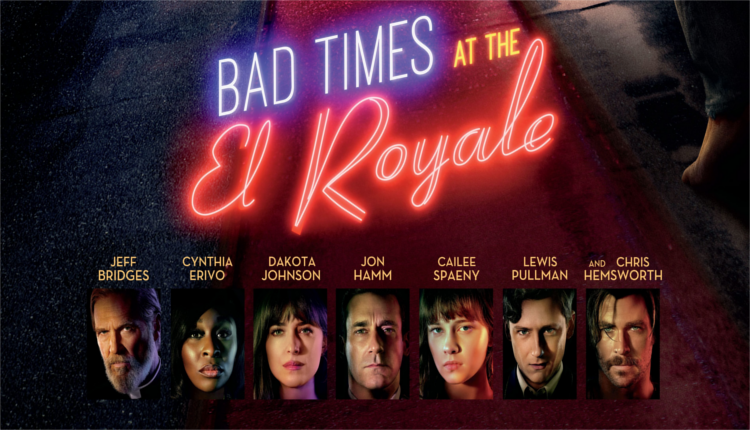Victors of The Night | Identity and Reflection in Bad Times at the El Royale
As the film title suggests, things get worse for the seven characters with dark histories who seem to randomly collide in 1969 at the Lake Tahoe El Royale Hotel—a decaying former favorite of Vegas’ rat pack. The gimmicky hotel sits half in California and half in Nevada, depicted by a red line that drawn throughout the property: the sense of straddling between two places or identities—good or bad; past or present—is imbedded in the film. These characters are faced, on this fateful night, with rectifying who they are.
The nonlinear structure of the film follows each character by focusing on an individual hotel room and the history of the character in that room. It’s impossible not think of Quentin Tarantino as “Room 1” flashes on the screen, time is fast-forwarded, and rewound, and over-the-top violence ensues. The absurdity of the characters is set against the brutality of the violence, and it’s unclear where the story is going. Writer-director Drew Goddard has said, “Nobody has to watch this movie more than me, so if it gets too straightforward I get bored. These movies take years out of my life so in order to do them, I have to find ways to keep myself guessing. There are a couple of big turns that the movie takes that are because I started to grow tired with the story, and I think it led us to some interesting places.”
Remove the violence, and the film is ultimately about identity. None of these characters, except for perhaps one, are who they claim to be. The film begins during the daylight, in a playful, comedic fashion, as priest Father Flynn (Jeff Bridges), singer Darlene Sweet (Cynthia Erivo), and vacuum salesman Laramie Seymour Sullivan (John Hamm) arrive at the lobby of the El Royale to check-in for questionable reasons. Hotel manager Miles Miller (Lewis Pullman) finally wakes up as another guest, Emily Summerspring (Dakota Johnson) makes it a crowd. Finally, they each settle into their rooms. When the sun goes down and the rain begins to fall, the truth about these characters begins to unravel.
The late 1960s sits as the backdrop of the film. Vietnam, the music scene, Nixon and Hoover, and Manson and the cult movement snake their way through the plot, but never surface in any meaningful way.
The film plays, quite violently, with the notion of projection and reflection. The characters contrive their outward identities so that they can do what is necessary behind the privacy of their hotel room’s closed door. But privacy is as much of an illusion as identity, and both quickly explode into the chaos of gunshots and breaking glass. When cult leader Billy Lee (Chris Hemsworth) shows up, the characters are given, more-or-less, a choice to reveal their motives and who they are or to cling to their contrived selves and face the consequences.

Mirrors, as a motif, appear throughout the film. Each character, in at least one scene, looks into a mirror and is challenged by reality of what they see—either their physical appearance or a seeming disbelief of the actions in which they’re taking. Mirrors are smashed—false realities are shattered—and the dark layers of these characters are further exposed.
Yet, the questions that drive the plot go almost entirely unanswered. In the end, there is little resolution, except for the fact that maybe, the two characters who are most able to come to grips with their pasts are the victors of the night.

